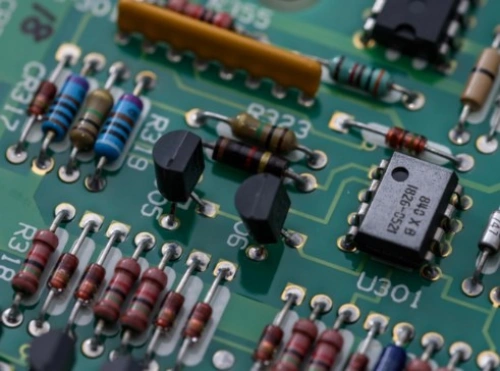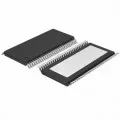OUTLINE:
Demystifying: How Does An Integrated Circuit Work
 512
512In the era of digitalization and highly-developed information technology, Integrated Circuit (IC), as the core component of electronic equipment, its importance and applicability is self-evident. From smartphones and computers to household appliances and medical equipment, almost all modern electronic devices are inseparable from integrated circuits. So, how exactly do integrated circuits work?

Image Source: Censtry Electronics
What Is An Integrated Circuit (IC)?
Integrated circuit is the interconnection of multiple electronic components (such as transistors, resistors, capacitors, etc.) and wiring, which is made of a semiconductor chip or dielectric substrate, and then packaged in a tube shell to form a miniature structure with specific circuit functions.
Basic Structure of An Integrated Circuit
The basic structure of an integrated circuit includes three core components, i.e. transistors, capacitors and resistors. These compact components work together to achieve high integration, miniaturization and high performance of IC, which provides strong technical support for the development of modern electronics.
Transistors are one of the most basic components in integrated circuits, and their main functions include amplifying, switching and controlling the flow of electrical signals. Common types of transistors include field-effect transistors (FET) and bipolar junction transistors (BJT). Moreover, an integrated circuit may contain thousands of transistors that perform complex circuit functions through specific circuit layouts and connections.
As for capacitors, they are mostly used to store charge and are commonly considered as the energy storage section in the circuits. And resistors are applied to limit the flow of current, adjust the voltage and current distribution in the circuit.
The Working Mechanism: How Does An Integrated Circuit Work?
The working mechanism of an Integrated Circuit (IC) is a complex and delicate process involving the integration and collaboration of multiple electronic components on a small semiconductor chip. The following is a detailed introduction to the working principles of integrated circuits:
Firstly, the basic composition of integrated circuits is the foundation of the efficient working process. Integrated circuits are mainly made of semiconductor materials (such as silicon, Si), on which a variety of electronic components are integrated, including transistors (mainly field-effect transistors and bipolar junction transistors), resistors, capacitors, etc. These components are made into a unified circuit by photolithography, doping and other processes, and are laid out on the chip to connect with each other.
Secondly, the core component of the integrated circuit, transistor, is capable of realizing the function of switching and amplifying, which often controls the flow of current. When used as a switch, by controlling the input voltage or current, the transistor can turn the circuit on or off, thereby controlling the flow of current. When used as an amplifier, a small input signal can be amplified into a larger output signal, which is widely used in audio and RF amplification. By controlling the on-off state of the transistor, the integrated circuit can control the state of the output signal according to the change of the input signal. The components inside an integrated circuit are connected in a specific way to build circuits with specific functions, such as logic gates, amplifiers, oscillators, memory, microprocessors.
Thirdly, these signals will enter the internal structure of the integrated circuit through the input pins. Inside the IC, electronic components (such as transistors, resistors, capacitors, etc.) are processed according to the characteristics of the input signal. For example, transistors can control the flow of current according to the changes in input voltage, to achieve switching or amplifying functions. Resistors and capacitors are used to regulate current and store charge. Also, integrated circuits can contain both digital and analog circuits. Digital circuits usually handle discrete signals, such as binary data, while analog circuits handle continuous signals, such as sound and light. Many integrated circuits are capable of processing both digital and analog signals. Meanwhile, integrated circuits can perform operations such as amplification, filtering, conversion (such as ADC and DAC), modulation and demodulation of signals. Digital integrated circuits are capable of performing logical operations, such as addition, subtraction, multiplication, division, comparison, etc., which are implemented through logic gates. As for signal output, the processed signal is transmitted to the outside of the integrated circuit through the output pin for use by other electronic devices. These output signals can be amplified signals, signals after logical operations, etc.
The working process of an integrated circuit includes input signal receiving, processing and output signal sending. To begin with, the input signal is transmitted to the integrated circuit, and then the electronic components in the integrated circuit are processed according to the characteristics of the input signal, and finally, the processed signal is transmitted to the output port for other electronic devices. The design and manufacture of integrated circuits requires careful planning and calculation to ensure that the flow path of current is shortest and electromagnetic interference is minimal, thus achieving the highest speed and accuracy. Special materials and processes are used to ensure the stability and reliability of the circuit.
The working mechanism of integrated circuits is not limited to simple signal processing, it also covers complex data processing and storage functions, and is playing indispensable role in modern electronic equipment.
The Manufacturing Process Of An Integrated Circuit
The manufacturing process of integrated circuits is a complex and delicate process involving several key steps. Here are the main stages of the process and their brief descriptions:
1. Layout Design
To determine the position and connection mode of each function module in integrated circuit, Computer Aided design (CAD) software is used to draw circuit diagrams and layout drawings, which will serve as the basis for subsequent manufacturing steps.
2. Mask Fabrication
To transfer the designed circuit pattern to silicon wafer as the basis for subsequent processing, the circuit pattern is transferred to a lithography mask using a lithography machine to form a mask.
3. Wafer Preparation
To prepare silicon wafers for integrated circuit manufacturing, it is needed to select the appropriate silicon material, and then clean, polish and do other treatments to ensure the flatness of the wafer surface, which is crucial for the production of subsequent circuits.
4. Mask Alignment and Exposure
To align the fabricated mask with the wafer and transfer the circuit pattern to the wafer surface by exposure, precise alignment and exposure are performed using a lithography machine to ensure accurate transfer of circuit patterns.
5. Deposition and Etching
Form the required circuit structure on the wafer surface by means of chemical vapor deposition (CVD) or physical vapor deposition (PVD), material is deposited on the surface of the wafer to form a thin film.
The use of chemical etching techniques is to remove unwanted parts of the material on the wafer, leaving only the desired circuit structure.
6. Ion Implantation
To change the electrical properties of silicon wafers to meet the performance requirements of integrated circuits, a specific type of impurity is doped into the silicon wafer to change its electrical properties such as conductivity through the ion implantation process.
7. Metallization
To form wire, connector and other circuit components on silicon wafer by depositing metals (such as copper, aluminum, etc.) on the wafer, and using techniques such as electroplating to improve electrical conductivity and corrosion resistance.
8. Packaging and Testing
The finished chip is packaged in a plastic or ceramic package to protect the chip and provide an interface to the external circuit. And the function and reliability test of the packaged chip is to ensure that the correctness and performance of the circuit meet the requirements.
Characteristics Of An Integrated Circuit
Integrated Circuit (IC) has a series of remarkable characteristics, which make it widely used in electronic equipment.
High integration: Integrated circuits can integrate hundreds or even thousands of electronic devices into a tiny chip, greatly reducing the volume of electronics through miniaturization technology, thus greatly improving the integration degree.
Small size and lightweight: Compact integrated circuit chips are only a few square millimeters in size and very light in weight. This allows integrated circuits to be easily embedded in a variety of micro devices, reducing the overall volume and weight, and greatly facilitating people's carrying and use.
Low power consumption: Because the device density in the integrated circuit is high and the signal path is short, the energy consumption of signal transmission is greatly reduced. At the same time, the operating voltage of the integrated circuit is usually low, which further reduces the circuit power consumption. This feature makes integrated circuits widely used in portable electronic devices, such as smartphones, tablets etc.
High reliability: The electronic devices in the integrated circuit have high density and low working voltage, so the failure rate is relatively low under the same working conditions. This improves the reliability and stability of electronic equipment, which is especially important for long-term stable operation.
Low cost: The production cost of integrated circuits is low, and due to high integration and small device size, relatively few materials are required. In mass production, integrated circuits have obvious cost advantages, thus promoting the popularity of electronic devices and the development of the market.
Easy production and maintenance: ICs adopt standardized production process and packaging technology, making the production more efficient and automated. At the same time, due to the low failure rate of a single integrated circuit chip, it is relatively simple to maintain.
Actual Applications Of Integrated Circuits
The practical application of integrated circuits is extremely extensive, covering almost all modern scientific and technological fields.
1. Communication
Mobile communications: Integrated circuits play an important role in mobile phones, base stations and other devices, providing multimedia capabilities, high-speed data transmission, GPS positioning, while improving battery life and network coverage.
Wired and wireless networks: In the field of wired networks, integrated circuits provide high-speed data transmission, Internet access, multimedia playback and other functions; In wireless networks and satellite communications, integrated circuits are responsible for signal transmission and processing.
2. Computer
Hardware: Integrated circuit is the core component of computer hardware, including CPU, memory, graphics card, etc. These chips integrate a large number of transistors and other electronic components to achieve high-speed computing and data processing functions of computers.
Data storage: Memory, as a type of integrated circuit, is widely used in computers to store binary data, including static memory (SRAM, DRAM, ROM) and dynamic memory (FLASH, EEPROM).
3.Automotive electronics
Automotive electronic systems: Integrated circuits play an important role in automotive navigation, audio and video entertainment, vehicle controller communication, etc. For example, automotive fan control, variable resistance potentiometers, reversing radar and other devices are controlled by integrated circuits.
Security system: In the field of security monitoring, integrated circuits are used to achieve video surveillance, alarm systems and access control security systems, etc., to protect people's property and safety.
Final Verdict
By controlling current and voltage to realize signal processing and transmission, integrated circuits not only realize the rapid transmission and processing of information, but also promote the rapid development of human society. With the continuous progress of technology and the continuous expansion of application fields, the future of integrated circuits will be brighter and broader.

Disclaimer: The views and opinions expressed by individual authors or forum participants on this website do not represent the views and opinions of Chipsmall, nor do they represent Chipsmall's official policy.

share this blog to:











